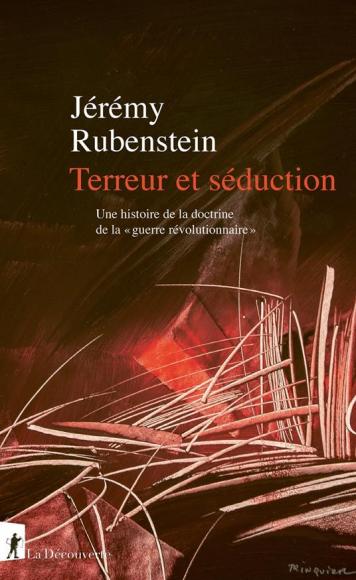Jeremy Rubenstein
Ed. La Dècouverte, 2022
pagg.336
This book by Jérémy Rubenstein (Terreur and Seduction. A history of the "revolutionary war", La Dècouverte), fits very well into the climate of the renewed interest that has emerged in France, and not only, for the DGR, the "doctrine of revolutionary war", which we have been witnessing for some decades.
After a period of oblivion, following the explosion and rapid affirmation of this new strategic thought in France in the fifties and sixties of the last century, with a "tail" in the early seventies in the nations of South America ruled by dictatorial regimes, records the rebirth of this doctrine in the early XNUMXs with the outbreak of irregular conflicts in Iraq and Afghanistan. Thanks to the reworking of some fundamental principles of the DGR, variously declined in the US military doctrine of the COIN (Counterinsurgency).
The book is structured in two main parts and is divided into 14 chapters.
The author traces the history of the DGR starting from its origins, which are based on the experience of more than a century of counter-subversive practices employed by the French colonial army, from the conquest of Algeria in 1830 to the apogee of the Imperial Republic, coinciding with the year of the Colonial Exhibition of 1931. And it is precisely in the colonial army that Rubenstein traces the "fundamentals" of the counter-revolutionary doctrine: conception of the role of the army, of war and of relations with the civilian population and with the enemy. Themes these, relatively unrelated to the metropolitan army.
Thus the strategies implemented in the overseas territories by a triad of generals are examined: Bugeaud, Gallieni, Lyauteney. According to Rubenstein, the historiographical vulgate that presents the three soldiers as protagonists of three successive phases of French colonization: conquest, pacification and construction of the nation is a historically false representation (p.18). All three of these soldiers in fact supported and practiced a military occupation based on repression, to impose terror by resorting to the use of force, torture, murders and enforced disappearances. However, these practices were associated with a policy tending to "conquer hearts and minds", pursued through instruments of involvement and participation of indigenous elites in administrative activities.
Subsequently Rubenstein analyzes the "two central elements" (p.44) that the Second World War brings to the elaboration of the future doctrine of revolutionary warfare: psychological warfare and the commandos.
The central tool of psychological warfare is propaganda, which uses all the media (at the time) available, newspapers, radio, cinema. But psychological warfare is not reduced to propaganda alone, it has a vaster arsenal of methods of disinformation and "intoxication": rumors, false news, etc. Münzemberg, Goebbels and Bernays - respectively in the service of the Communist International, National Socialist Germany and the capitalist system of the United States - are the three masters of information manipulation who "fix the main methods of mass propaganda", subsequently elaborated and refined, but which will never be questioned (p.47).
In the third chapter Rubenstein examines the birth during the Second World War, within the British armed force, of small military units that take the name of commandos, later defined as "special forces", such as SAS (Special Air Service) or SOE (Special Operations Executive), in charge of clandestine operations in occupied Europe. These special units are modeled on by the French military. Other tools of cooperation between the allied forces, always on the initiative of the British, are the STS (Special Training School) and teams jedburgh. Units made up of a British officer, a French officer and an American officer, one of whom necessarily had to be a radio broadcast specialist. From these elite forces come a large number of those who went on to play an important role in subsequent irregular conflicts.
The fourth, fifth, sixth and seventh chapters represent the central part of the book, in which the emergence and institutionalization of the DGR in the aftermath of the Second World War is analyzed in depth, following the formalization of this new strategic thinking by the French officers employed in Indochina.
With the Indochina war, France experiments with the use of resistance groups (maquis) and sends about sixty men from the special forces, mainly Jedburghs and SAS. The program is part of "Force 136", the Asian unit of the British SOE.
Beyond the experience of commando and guerrilla techniques and the learning of elaborate tools of psychological action, a third source of inspiration, essential to feed the reflections of the DGR theorists during the Indochina war, is the knowledge of communism . But this is a very superficial reading of the texts of Mao Zedong or GIAP (p.98). It is mainly the experience gained in prison camps that offers the French military the basis of knowledge of communist ideology. For them, in reality, communism is the concentration camp universe of the prison camp, "it is the society of the camp" (p.99).
An entire chapter is then dedicated to three key theoretical figures of the DGR, Charles Lacheroy, Roger Trinquier and David Galula. According to Rubenstein, the concept of "parallel hierarchies", an expression coined by Lacheroy, which designates the whole of the triple network, professional, territorial and party, which cages the people, is central in the elaboration of the doctrine of the revolutionary war; and through which the minority represented by the communist party is able to exercise total control over the entire population (pp.103-104).
But the DGR would be incomprehensible if the concept of parallel hierarchies were not associated with the so-called "five-phase scenario", also used by Lacheroy and taken up with very slight variations by Trinquier and Galula. For these three theorists, the revolutionary war takes place in five phases. The first phase can only be detected by experts: military, police, judicial or political personnel specialized in subversive warfare. It is characterized by "agitations", which are in fact normal demonstrations in any democratic regime, essentially, strikes and street demonstrations. This initial phase is inevitably followed by four more to lead to the seizure of power by the insurrectionary party.
For DGR theorists, the succession of phases is "inevitable" (p.114), so it is logically necessary to prevent subversive warfare in its first phase, also for humanitarian reasons, since the subsequent phases will necessarily be more violent. From this assumption, according to Rubenstein, it follows that from the moment in which the military believes they know what is about to happen, they enter into a preventive logic, for which it is always preferable to annihilate the adversary even before he has shown the slightest violence (p. 114). Which implies a permanent state of war which justifies a police state.
It is a critical analysis of the "heart" of the revolutionary war doctrine, from which it emerges that its principles logically lead to the suppression of all forms of opposition and dissent towards those in power.
The peculiarity of the DGR, however, is that it is not satisfied with just wanting to overthrow its adversary, but it sets out to replace or create ex nihilo a new articulation of state structures: army, political party system, judicial system. Counterinsurgency also needs a positive principle, an idea around which to structure propaganda and win hearts and minds (p.115).
In short, the DGR needs an ideology. Not one in particular, but the one that best suits the population to be controlled. However, contextually with the practices soft of social control the use of strong methods is foreseen to separate "the wheat from the chaff" (p.116), that is to discriminate that part of the population that collaborates with the power from that which disagrees and opposes it. Hence the recourse to the census and the mass deportation of the population in reticulated and compartmentalized areas controlled by the military.
On the part of the seduction of the population, there is also the "singular experience" (p.127) of the "commandos noirs" of General Bollardière, so called because they wore a black Arab-style headdress. The black commandos, who sometimes went unarmed, were to represent the "left hand" army, with the task of winning hearts and minds through the implementation of social programs, the construction of infrastructure, hospitals and schools.
With the chapter on the "Battle of Algiers", the author explores the question of the indiscriminate use of torture, widely practiced by the French military in Algiers, not only to obtain information but for the purpose of terrorizing the population. Of course, the theorists of the DGR have never explicitly recognized that they resort to torture, but they have insisted on the need to resort to "specialists" to make the prisoner speak at any cost, who is compared (in Trinquier's writings, for example) to the combatant on the battlefield who knows he has to face suffering and even eventually death.
Rubenstein demystifies the fallacious arguments of the French military aimed at presenting torture as a form of combat and, therefore, the tortured as a regular soldier on the battlefield (p.145). Nor can the use of torture be justified through the famous "time bomb scenario". According to which a prisoner who knows the place and time when a bomb will go off, under torture will provide the information that will save many lives innocent (p.146).
In reality, the practice of torture does not have the declared aim of extracting information as its main objective. Rubenstein argues that torture is fundamentally one of multiple tools used by DGR supporters to terrorize and control the population, and only incidentally an intelligence tool (p.148). Here Rubenstein openly polemicises with those researchers, such as Élie Tenenbaum (author of the excellent Partisans and Centurions. A history of the irregular war in the XNUMXth century, Perrin, 2018)*, who believe that the use of torture is a "deviation" in the application of the counter-insurgency doctrine (p.163).
The second part of the book opens with a chapter dedicated to a reconstruction of the historiography of the DGR in the French university world during the 159s, mainly following the "renewal of historiography on the Algerian war" and the opening of new archives ( p.XNUMX)
The studies can be divided according to a fundamental divergence: one side conceives counter-insurgency as an essentially technical tool that uses political power to annihilate its enemies; the other side, however, believes the counter-insurgency essentially a political tool that will inexorably transform the rule of law into an anti-democratic regime (p.163).
In the ninth chapter the author examines the XNUMXs, which marked the official eradication of the DGR in France just two years after the conclusion of the battle of Algiers ("won militarily but lost politically", according to the Vulgate of the military), which marked the highest point in the affirmation of the doctrine. So much so that it is officially codified in the "TTA 117" employment manual of the French army.
The Gaullist government put an end to the dominance of this strategic thinking, which from official army doctrine became a political threat, the Gaullist government (p.179). Officially, because De Gaulle had made the choice of nuclear weapons, in view of the new doctrine of “force de frappe”, that is, of the "doctrine of deterrence". However, according to the author, de facto the counter-revolutionary doctrine continued to be employed in the territories of the former colonies (p.182).
The following two chapters of the book are devoted in particular to the circulation of the DGR, starting from the 207s, in the United States and Argentina. Thanks to the dissemination of theoretical writings within schools and military training institutes. Thus among the applications of the principles of the DGR in the United States must be counted the "doctrine of national security" or DNS (p.185). They also contributed to the spread of the doctrine, the mercenaries, in the Africa of decolonization (p. XNUMX), the OAS, the spooks Gaullists (p.187), and the great "US" research institutes (p.206).
In the twelfth chapter Rubenstein returns to the US applications of the DGR, declined as a counter-insurgency doctrine, in the Vietnamese conflict. As the Phoenix program, aimed at destroying the political infrastructure of the Viet Cong, which led to the elimination of over 26 Vietnamese civilians.
The last two chapters are devoted to the evolution of counterinsurgency principles from the 257s onwards, implemented both by states and by private companies and organizations. Nicaragua, Rwanda, Algeria, Iraq and Afghanistan become the battlefield where new counterinsurgency techniques borrowed from the DGR are practiced. But the police forces around the world are also adopting counterinsurgency methods against the so-called "enemy within" (p.XNUMX). While the business world's recourse to counter-revolutionary methods is manifested through recourse to mercenary work and psychological weapons.
In the last two decades there has also been the rehabilitation of the principles of the DGR in the French army, then made official with the drafting of a new anti-insurgency doctrine and the related production of operating manuals, which in some points refer precisely to the "five-phase scenario ” (p.292).
Finally, in his epilogue, the author explains the reason for the current "dangerous proliferation" of the DGR with the revolutionary war doctrine being a strategic thought that "posits the conflict in terms of sovereignty" (p.290). Consequently, Rubenstein states, "from an empire to a small fiefdom, all powers find in his methods a useful toolbox for asserting their authority" (p.290).
In conclusion, Rubenstein's book offers us an excellent reconstruction of the doctrine of revolutionary war - even if in some parts it appears repetitive - and of its diffusion and use not only in the military sphere, with a particular focus on the issue of torture. Thus offering a significant contribution to the debate among specialists not only on unconventional wars but also on the new forms of control over the population that the holders of power (be it state or private organizations and even criminal organizations) are exercising in an era , like ours, marked by the "trivialization of hyperviolence" (p.286).
Nicola Festa












